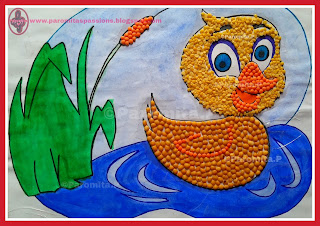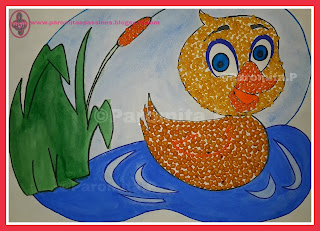Pulses Pasting Activity
Pulses or Dal pasting activity is an artwork
for the growing and learning children. For this activity,
we use different kinds of pulses or grains such as seeds, rice, colourful lentils, or any
other cereals that we normally get to see in the kitchen. Pulses artwork
requires the artist to have a love and patience for doing the activity. This
activity needs the realistic materials to be pasted on the painting, it is a
kind of mosaic piece of activity on the cardboard. The work brings out the best
creative talent of the artist, as it gives immense varieties to be modelled either
in a piece of paper or even a large thick base depending upon where the artist wants to set the base of the model.
Pulses Pasting Activity is basically a very
easy and decorative artwork for children or people of all ages. The procedure
for the activity has no hard rules set,
it just requires drawing, painting, pasting and creating the model from the artist's constructive
aspects. This activity is great for everyone who loves art. The students
take great interest in doing the activity, as it is safe, easy and has no
harmful materials that would cause any disturbance to the child. They learn
while doing the activity, they learn about the names of the different varieties
of pulses, the benefits of those pulses when it is cooked and why we eat them. Children
also learn to sort out the colour, varieties and different sizes of the pulses. This
activity encourages them to eat the pulses when cooked as few children hesitate or crib
while eating dals in their meal.
There are various attributes related to the Pulses
Pasting Activity depending on which the child is able to gain more ideas and skills. The activity is similar to sorting that
helps the child to build the maths skills and enhance observation. I’ve compared
the Pulses Pasting Activity with the sorting activity because children while
they paste the dals on their drawing basically they would first observe the
patterns of the colours, then chose the pulses according to that colour to paste
on the drawing. Preschools often carry out this activity in order to help the
child recognise, differentiate and learn the names of the various pulses and
grains.
A Duckling
For this Pulses Pasting Activity, I’ve modelled a Duckling and used three varieties of pulses that were currently available in my kitchen, those are split pigeon peas (Toor Dal), Red Lentils (Masoor Dal), Petite Yellow Lentils (Moong Dal). This activity is very easy and not very sophisticated for the young children. I have shared the step by step procedure for the pulse pasting activity. After the completion of this activity you can spread a rectangle piece of transparent lamination sheet covering the entire model because often few dals get removed as and when the model is moved from one place to another, so if you want to preserve your artwork say for a lifetime, then I recommend to cover the model either with transparent cello tape or cellophane sheets if you don’t find lamination sheets in the market, however in some stationery shops transparent sheets may be available.
Materials Required:
- A4 sheet paper
- Pencil
- Different varieties of Pulses
- Paints
- Paintbrush
- Glue
- Sketch Pens
- Forceps (optional)
- Lamination sheet (optional)
- Draw the figure using a pencil on the A4 sheet paper (a rough figure of your desired model)
- Paint the figure and leave it to dry for two minutes.
- Now draw the outlines using sketch pens (preferably black sketch pens)
- Apply glue to the required places in batches, that is only the portion where you want to stick the pulses.
- First, finish with applying glue on the wings and put a handful of Toor Dal on it. Press on the dals lightly with your fingers so that dals will stick on the paper firmly.
- After finishing with toor dals, apply glue and stick the masoor dals.
- Similarly, continue applying glue, then stick the pulses on the desired places and press gently for the firm sticking of the pulses on the paper.
- In some cases, few dal remain unattached to the paper, so I have used a forcep to fix the tiny pulses firmly on the paper. (however, it is not necessary for the children to carry out the activity with a forcep)
- Allow the glue to dry and set the pulses properly on it.
- After
1 hour cover the model with a transparent lamination sheet.
Note: The pulses and Dals usually get moistened and catch tiny worms, therefore before using the lentils for the activity soak the pulses in water for 30 minutes, then you can either dry them under the sun for about the whole day or roast them in a cooking wok on the flame for 5 minutes. This prevents the worms growing due to moist weather and you can preserve the Pulses and your activity for several years.
Paromita Pramanick ©2017. All Rights Reserved.








very nice and useful to me
ReplyDelete